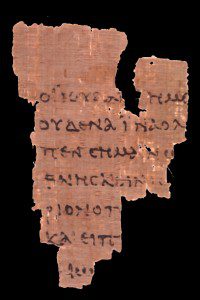Ancient Ephesus and the New Testament
Ephesus in the New Testament
Early Christianity was significantly an urban movement. This might sound surprising if you’re used to thinking of Christians continuing the mode of Jesus, whose ministry happened largely (but not only) in rural Galilee. Yet, when we pay close attention to the facts of Christianity in the first-century A.D., we see the prominence of cities, including Jerusalem, Antioch (in Syria), Corinth, Rome, and Ephesus.

Arguably, Ephesus was the most important city for Christians at the end of the first century. Jerusalem had pride of place at first. Rome was growing in influence in the early second century. Yet, not only was Ephesus situated rather in the center of an area in which Christianity was thriving, but also it was an important city in its own right. Moreover, it was associated with several prominent Christians, including Paul, Timothy, John, and perhaps even the Virgin Mary. (People who live near Ephesus today, along with many Roman Catholics throughout the world, believe that Mary lived just outside of Ephesus during her last days on earth. The photo to the right shows the center of Ephesus today, Curetes Street with the Library of Celsus in the distance.)
The fact that Christianity was primarily an urban movement helps to explain its rapid spread throughout the Roman world. Cities were the hubs of travel, trade, and culture. If one influenced a major city in a region, then one would also be able to influence the whole region. Thus, for example, if Paul were to establish a vital Christian presence in Ephesus, then this would spill over to other cities throughout Asia Minor.

When we think of Ephesus and the New Testament, most of us would at first remember the letter of Paul called “The Letter to the Ephesians” or, simply, “Ephesians.” But it turns out that the connection between this letter and Ephesus is rather tenuous. Some of the earliest manuscripts of the letter do not contain the words “in Ephesus” (en Epheso in Greek). For example, Papyrus 46, one of the oldest and most reliable manuscripts of Paul’s letters, does not mention Ephesus. (The picture to the right shows part of this manuscript.) Many scholars believe that the so-called Letter to the Ephesians was originally a circular letter intended for several churches, including the church in Ephesus. This many also explain why the letter has so little in it that is uniquely Ephesian (no mention of the Temple of Artemis, for example).
The oldest references to Ephesus in the New Testament are found in Paul’s First Letter to the Corinthians. There, he writes:
If with merely human hopes I fought with wild animals at Ephesus, what would I have gained by it? (1 Cor 15:32)
I do not want to see you now just in passing, for I hope to spend some time with you, if the Lord permits. But I will stay in Ephesus until Pentecost, for a wide door for effective work has opened to me, and there are many adversaries. (1 Cor 16:7-9)
Unfortunately, we don’t know exactly what Paul means by fighting wild animals at Ephesus. The Ephesians were enthusiastic for games in which African animals fought against animals or people. But it seems most likely that Paul is speaking metaphorically, referring to some conflict that he had in Ephesus. Nevertheless, it does seem obvious that Paul was writing the letter we know as 1 Corinthians from Ephesus, where he was engaged in missionary work for an extended period of time. It was during this time that he must have “fought with wild animals.” Perhaps Paul was referring to the conflict we read about in Acts 19. I’ll turn to this in my next post in this series.










